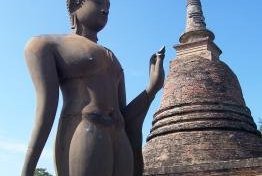
Of the three Thai WHS that I visited this was my favourite. It is comparable to Ayutthaya, being a former Thai capital now just a pile of glorious ruins. However the ambience of this site was a little nicer, being set in a park dotted with small ponds and lakes, and there also seemed to be more statuary on display. In fact the very elegant and beautiful Buddha statues that Sukothai is famous for really were the undoubted highlight of the place for me, and every set of ruins had a good example.
I used this site as a lunch time stop over on my way between the northern city of Chaing Mai (my personal highlight of Thailand) and Bangkok. It provided a great way to break up the long bus journey, but I think you could perhaps spend an evening there if you wanted to relax and enjoy the site. It is especially good in late November when it becomes one of the best places to see the lanterns of the Loy Krathong celebrations.
[Site 6: Experience 6]
Keep reading 0 comments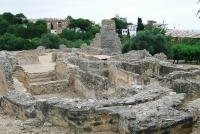
I agree that the listed sites within the city are nothing spectacular compared to Merida so I went to search out the sites on the periphery of the city.
The aqueduct, known locally as Puente del Diablo, is in a leafy park to the north of the city, reached by bus #5 from the city centre. Whilst it is in a good state of repair it nowhere near as spectacular as the one in Segovia.
Centcelles villa is at the village of Constanta, reached by the Plana bus. The main feature is the mosaic design on the domed ceiling of the basilica.
Els Munts, located a short walk from Altafulla station, is a rather disappointing excavated village.
The Arch of Bera, accessed by a Penedes bus from Torredembarra station, is a rather forlorn and incomplete monument.
Keep reading 0 comments
This was perhaps the single most unique experience I have had in visiting a WHS. With a group of really good friends I made the trip in a day from Siem Reap in two chartered taxis.
The site itself was rather impressive; it was a destination for pilgrims during the Angkorian period and had some fine temples drawing influence from the magnificent Banteay Srei style at Angkor. Altogether there are 4 sets of temples. The first that we encountered was perhaps the most impressive, looking a little more delicate with finely carved detailing. The final group was the largest set of temples and it was enclosed inside a nice cloister. There was a Monk located in the central temple burning incense and talking to us. Behind this final group of temples is the cliff which offers expansive views over the plains of northern Cambodia.
The uniqueness of visiting the site though come from two factors, firstly it is currently a pretty remote place to get to (from the Cambodian side) but this is being drastically improved. Secondly is that the site is now essentially a Military camp, as Cambodia and Thailand have regularly escalated tensions over the sovereignty of the site, and it is now essentially a semi active ‘front line’.
Due to the tense military situation in the area, and also the desire to develop tourism the road links to Preah Vihear have been greatly improved in recent months and form the look of the work going on will …
Keep reading 0 comments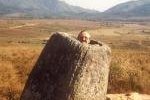
Spent two days in Wudalianchi last October 2010.
It is amazing to learn about the preparations the local government are doing for the WHS Convention next year. Along with Hangzhou West Lake, this wonderful place is China's bid for 2011 world heritage site.
I found out from the locals that a new airport is being constructed in this small city. A train station is also being built. Most travel books recommend taking transportation from Harbin (Heilongjiang Province capital) or Qiqihar or Daqing to get to Beian - the closest city to the scenic spots of Wudalianchi. Transportation from any of these three cities to Beian takes 4-5 hours; and then another hour from Beian station to the park itself. Hence, I can say that the distance of the park can be a hindrance to lure tourists.
But that said, the place is definitely worth the visit. IMHO, I also think it will best "represent" a Heilongjiang World Heritage Site, instead of the proposed germ warfare site in Harbin.
A guy from the local tourism bureau said that there are multiple areas being considered for inscription. I got to visit three: Longmen Stone Village, Laohei Volcano and Wenbo Volcanic Spring.
Keep reading 0 comments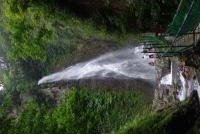
As to how to see and what you can see at the site in Arras, all you have to do is to try to take paths around the fort that are closest to the fort. Well, you can hardly see the inside of the fort, but you can see the outside, and this is all you can see there. These paths are also created for hiking and biking. One can actually walk around the fort and see the fort at various points along the way.
Also remind you that Arras' belfry is also inscribed in the WH list.
So Arras has TWO WHSs!
Keep reading 0 comments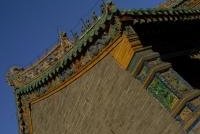
The Shenyang Imperial Palace may not be as grand as its Beijing counterpart; however, what makes up for its size is the intricate design of the buildings. The Manchu style of architecture is not like any other seen in most temples or buildings in China.
I stayed in Shenyang for two days and got to visit the other two Qing dynasty tombs in the city - Zhaoling and Fuling.
Keep reading 0 commentsAnonymous
Village souterrain d'Agongointo-Zoungoudo
Village souterrain d'Agongointo-Zoungoudo (On tentative list)
This is an amazing site of over 150 caves used during kindgom battles of over 400 years ago in the Abomey region of Benin. The tour guides are excellent and the site is set up so one can visit the interior of once cave fully in tact as well as climb down into the cave that was first identified when a bulldozer fell into it just a few years ago during road construction.
The grounds are lovely and include fantastic local huts, a playground for kids, and a gorgeous butterfly garden.
A great visit and right off the national road between Cotonou and Parakou at Bohicon.
Keep reading 0 comments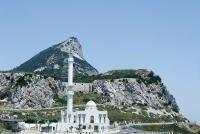
Spanish trains stop infrequently at the station at La Linea from where it is a short walk to the border. I walked across the border and entered the British enclave of Gibraltar from where I took a bus through the narrow streets of the town to Europa Point at the southernmost end of the peninsular. From here there is a commanding view of the Straits and North Africa beyond.
Whilst the state party's description of the site is full of historical references, I found these hard to identify amongst the jumble of modern shops, banks and apartment buildings. I fact I found the town quite claustrophobic and lacking in OUV.
Keep reading 0 comments
Whilst many buildings have been restored in recent years, most obviously Ulica Grodzka, which leads towards the Wawel and is one of the oldest streets in Krakow, gimmicky new additions have blighted the centre. The new "Crystal Fountain" which is not just a fountain but a banal glass pyramid glows in different colours at night, has ruined the view outside the Mariacki Church and detracts from Krakow's old world ambience. Krakow's Rad Miejska should be held accountable for failing to preserve the city in accordance with the UNESCO criteria making it a World Heritage site. It is an international disgrace that the Rynek has been blighted like this. Shame.
It really is a cheap tawdry gimmick and lovers of Krakow should demand its prompt removal. It's already one the annual Archi-Szopa Award for being the worst piece of new architecture in Poland
Keep reading 0 comments
Twyfelfontain is an impressive collection of rock carvings found on a hill in central Namibia. It was extremely hot on the day I visited and the climb in the beating sun (there is very little shade and it's steep) was tough. I would therefore recommend water, suncream, sunhat and visiting as early or late in the day as possible.
The carvings are incredible. Unlike some ancient rock paintings, it's very easy to distinguish which animals are which. Lots of iconic creatures feature, including an elephant, giraffes, ostrichs, a lion and gemsbok. Some of these are no longer found in the immediate area around the hills, and there is also an image of a seal which indicates the people had access to the coast, a long way off.
The site is not very developed and was fairly quiet when we visited. There were no signs of degradation or abuse and we were guided at all times by a well informed guide. Given its out of the way location I assume visitor numbers are probably still low compared to many World Heritage Sites. I found it worthwhile visiting, although I wouldn't go to Namibia solely to see this. Combined with the Skeleton Coast, desert, or a safari though it is worth a look.
Keep reading 0 comments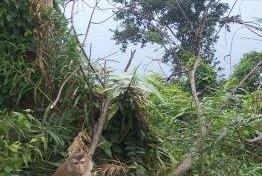
I wimped out a little on this one, and took an organised day trip from Bangkok's tourist enclave of Khao San Road. However I have to say the trip was pretty worthwhile, but I would have preferred to spend more time in the Park proper and perhaps got a little more chance to hike around and try to glimpse some wildlife.
After some stops for general touristy things like visiting a market, we entered the park and headed straight for it's highest waterfall at Haew Narok which provided a nice glimpse of the environment. Our guide didn't seem to concerned on keeping noise down to allow a better glimpse of some wildlife, and when we did finally see a chameleon up close the other members of the group seemed a little disinterested.
We then drove through the park and spotted some deer by the road side before stopping at a view point where there was a large group of macaques.
I was impressed by the infrastructure of the park, I really reminded me of the national parks in US that I have visited, except the food stalls sold eminently more tasty looking food. This reflected a lot of what I found in Thailand, it is a rapidly developing country and amenities for tourists are very impressive.
After we left the park we went for a meal at a 'Jungle Lodge' just outside the park proper. We then got to ride Elephants, I must admit I was not really holding out …
Keep reading 0 commentsIan Cade
The Archeological complex of Banteay Chhmar
The Archeological complex of Banteay Chhmar (On tentative list)
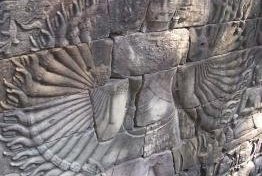
This is a little way off the beaten track, but well worth a visit if you are in North-Western Cambodia. The ruins are some of the most extensive from the Angkorian period and contain some particularly fine carvings, ranking along with the finest at Angkor Wat.
The remains are pretty extensive and are very much still ruins, you will have to clamber over toppled rocks for pretty much the whole time you are in the central complex so take a sturdy pair of shoes and a decent dose of common sense as some of the structures are very precarious. The most impressive single element was the carving of the multi armed goddess'. There are only two of these remaining after several other were brutally hacked of a sent out of the country in one of the most astounding pieces of cultural barbarism I have encountered. However it is not all bad news, I had a tour of the site with Mr Sy from the local Community Based Tourism project. This group along with the Global Heritage Fund have been putting in a lot of effort to promote the sites. The GHF have also been doing some extensive restoration and mapping of the area, both to help preserve it and to help with its nomination to the World Heritage list, an overview of the work can be found here. This would make a great WHS and would be suitable reward for the local and international efforts that have been put into …
Keep reading 0 comments
Rostaq fort is located at the foot of the impressive Western Hajar Mountains, a range of bare steep sided mountains. The fort itself does not seem as dramatically located though as the one nearby at Nakhal. Rostaq is distinguished by having a falaj flowing beneath it, but this feature is already included on the WHS list.
Rostaq is located on a loop road off the Batinah highway, and makes a delightful side trip when travelling between Muscat and Abu Dhabi.
Keep reading 0 comments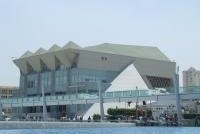
Alexandria's long and colourful history is what makes it such an interesting and diverse city. The remains from the Greco-Roman era are quite evident in the underground necropolises, the Roman theatre and nearby excavations, and artifacts brought from beneath the harbour also on display. The plan of the city was changed radically by an earthquake which toppled the Pharos lighthouse and submerged much of the city creating the harbour. The Ottomans used the stone from the lighthouse to build much of the Qait Bey citadel. Modern architecture is represented by the palaces built for King Farouk in the Montazah Gardens and the ultra-modern library complex completed in 2002.
Keep reading 0 comments
I was born in Germany and from 1950 to 1954 I lived in Speyer.I made my first Komunion and Konfirmation in the kaiserdome where I also was a Altarboy. I have lived in the US since 1956. When I visited germany for the firs time in September 2009 I vissited the Dome and I was dismayed as to what had been done to this great historic church.The inside is nothing like it was.It has been modernised,sanitized and sterilized of all that which made it a historical treasure. Even the Krypt which had been closed with two massive steel doors has been modernized. Very dissappointed.
Keep reading 0 comments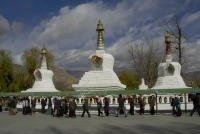
Visited the Palace as a side trip. Since individual travel is not permitted to the autonomous region, I was lucky to be part of an official delegation. Either that, or I join a tour group - which is usually overpriced.
Impressive! The Palace has preserved the best treasures. Personally, the best "museum" I've seen in China.
Keep reading 0 comments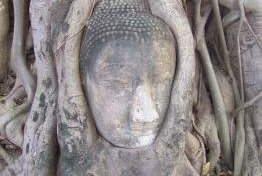
This was my first Asian WHS so it will have a little bit of a special place for me.
There are quite a few different ruins and temples to visit within the central area, each charging a separate admission fee. My favourite site was the first one I visited Wat Ratururana which had an impressive cluster of chedi's. The central one was particularly impressive as you could not only climb up it but also descend inside to see a small but impressively decorated chamber at its very heart.
I spent the best part of an afternoon dotting between the main sites, meeting fellow travelers and enjoying a relaxing stroll through the water lined park behind Wat Prah Mahathat. A week or so before I visited there had been pretty extensive flooding in the area and there were still a fair few places that were underwater. This meant I didn't get to visit any of the wats off of the central island. However it was very heartening to see that there had seemed to been a pretty good response from the local authorities to aid those affected by the flooding.
This was a really good day trip to make from Bangkok, and the sites seemed reasonably impressive.
[Site 5; Experience 6]
Keep reading 0 comments
The largest pre-Columbian city north of Mexico, Cahokia is a major archaeological site (it had a population larger than London's in the 13th century), but little known even within the US. For those with a reasonably big interest in history and archaeology, this is a very rewarding place to visit, but be sure to see the excellent museum in the visitor centre, and to join a (free) guided tour (very informative). Otherwise all those hills scattered around the area won't make much sense to you. If you climb atop the largest one, called Monk's Mound, you can even see the skyline of St. Louis and the Gateway Arch. The site can be reached by public transport as well (metro train to East St. Louis, then bus to Collinsville, then a 25-minute walk - not as bad as it sounds). I was pleasantly surprised that they really highlighted their WH status - not a matter of course in the US. There was even a WH flag next to the American one at the entrance - never seen one of those before...
Keep reading 0 comments
This is one of the finest roman cities that you can visit. The forum, Severan temple, arch and theatre are impressive. The setting is is in the hills with a triangular city layout. The mosaics in the museum are also among the best you will see.
Keep reading 0 comments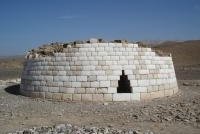
This was my favourite WHS on the Iberian Peninsular. The churches and their locations were spectacular, and the interior frescoes stunningly beautiful.
I started out from Poble de Segur and took the bus to Barruera via Pont de Suert. This bus arrived in time to catch the Traginer, a local minibus that visits the villages of Taull, Boi and Val de Erill. In the course of a day I visited the four churches in those villages, thanks to the driver of the Traginer who allowed me to get on and off at will. Finally I visited the church of St Feliu in Barruera before catching the bus back to Poble de Segur.
Keep reading 0 comments